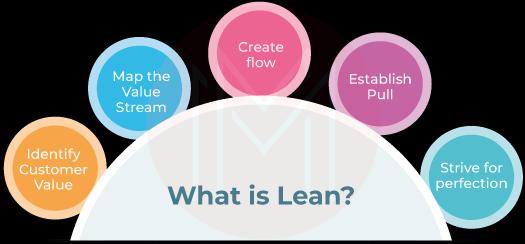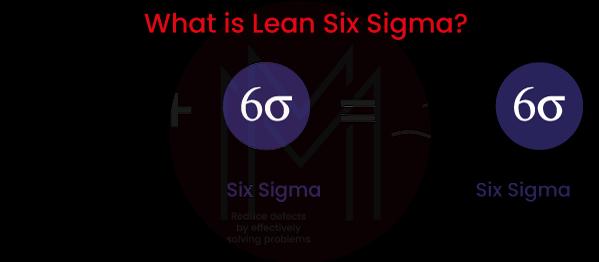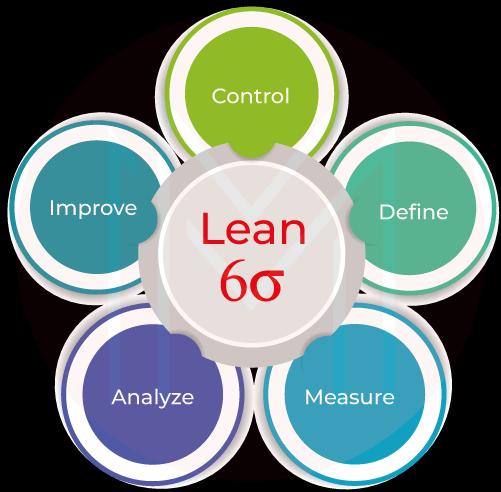- Lean Interview Questions
- Lean Manufacturing Tools
- Lean vs Six Sigma
- Six Sigma Interview Question and Answers
- What is Lean Management? - A Complete Tutorial
- What is Six Sigma Green Belt?
- Six Sigma Tools
- Six Sigma Companies
- Six Sigma Techniques
- Six Sigma Methodology
- Six Sigma Projects and Use Cases
- Six Sigma VS Kaizen
More and more organizations are committing themselves to process and continuous improvement. Lean Six Sigma, which combines the best methodologies from both Lean and Six Sigma, is the combination platter of process improvement. It gives organizations the tools they need to address issues and constantly improve their processes.
Companies implementing Lean Six Sigma frameworks have seen an increase in profits, improved productivity, and reduced wasteful practices. More than half of Fortune 500 companies follow these effective processes. Get to know what Lean Six Sigma is, the similarities and differences between Lean and Six Sigma, and more with a detailed explanation here.
What is Lean?
- The lean methodology starts with identifying a product or service that fulfills certain requirements and creates value for the customer.
- The process that produces this result, known as the "value stream," is then illustrated.
- This exercise reveals where wastes are located, allowing for the creation of a better process with "flow." Through the gathering of data surrounding this, these wastes become transparent, and together with the participants in the process, the process gradually improves.
- After that, you think about how to set up the process so that it can start when the client demands it and end exactly on schedule when the client wants it.
- People in the organization will identify where changes may be made and work on their own improvements. This results in an organization where everything is centered on providing what the client requests in a creative, effective, and efficient way.

| If you want to enrich your career and become a professional in Lean Six Sigma, then visit Mindmajix - a global online training platform: "Lean Training" This course will help you to achieve excellence in this domain. |
What is Six Sigma?
Although Six Sigma is more data-driven than Lean, both methodologies were developed at the same time.
The structured project management approach ( Define, Measure, Analyze, Improve and Control) DMAIC ensures that the root cause of the problem has been found before adopting a solution. By strategically and effectively utilizing the capabilities of your staff members within the organizational framework, the DMAIC Model allows you to maximize the value you offer to the client.
| Related Article: Six Sigma Interview Questions |
What is Lean Six Sigma?
Lean Six Sigma is a methodology that has been effectively used all over the world to enhance business operations in a sustainable and measurable way. It offers an approach called DMAIC (Define, Measure, Analyze, Improve, and Control) that helps organizations to create measurable results in an organized way with continuous improvement.
The first stage is to focus on the actual values that customers hold and then apply this understanding to processes. not a cent more or less This approach reduces costs, improves customer happiness, and shortens lead times. This approach's advantage is that it uses clients' extensive process knowledge and experience.
The Lean Six Sigma methodology enhances both the process and the quality. Lean aims to improve flow and business value. Process stability and effectiveness are priorities for Six Sigma. Together, they strengthen one another and are perfect allies.

Related Article: What is Lean Management
History of Lean Six Sigma
Toyota, a Japanese automobile manufacturer, developed lean methodology in the 1940s. Its goal was to eliminate unproductive tasks from the production process.
The Kaizen model from Japan served as the inspiration for the creation of Six Sigma, which was developed in the 1980s by an engineer at the American telecommunications company Motorola. In 1993, the business registered a trademark for it. This approach aims to identify and minimize production-related flaws. Additionally, it aims to make the production process's variability more efficient.
Large U.S. manufacturers tried to compete with Japan's better-made products in the 1990s, which led to the development of Lean Six Sigma. Michael George and Robert Lawrence Jr. first discussed the combination method in their 2002 book Lean Six Sigma: Combining Six Sigma with Lean Speed.
What are the five phases of Lean Six Sigma?

#1. Define
In this phase, the parameters for the process under analysis are established, and the intended performance for that process is determined from the viewpoint of the customer. This is to make sure a change improves rather than degrades the client experience.
#2. Measure
In this phase, the process, product, or service's existing performance is assessed to ascertain what is actually taking place, particularly from the standpoint of the customer. In order to guarantee that the analysis and solution are founded on actual performance, rather than hypothetical or anecdotal data.
#3. Analyze
Using the measured data, the process, product, or service is evaluated in this phase to identify the source (or sources) of variation that are the root of the issue. This is done to make sure the actual root cause(s) and not merely a symptom are found.
#4. Improve
A solution set of adjustments is planned and evaluated during this phase, which also involves evaluating potential changes to the process, product, or service. This is done to ensure the problem is solved, the desired effect is produced, and the variation diminishes or removes.
#5. Control
This step involves implementing the modifications, updating the supporting systems, and controlling the process, product, or service using statistical process control to make that the solution is completely implemented and sustained and to detect any performance degradation.
Because Six Sigma mainly relies on data, it may be used for any process, product, or service that has a defined performance target and measurable attributes.
Integrating Lean and Six Sigma
Both Lean and Six Sigma offer clients the greatest possible quality, price, delivery, and a more recent quality called nimbleness. Although there is a lot of overlap between the two fields, they both approach their shared objective from slightly different perspectives:
- Lean stresses reducing waste, whereas Six Sigma emphasizes reducing variance.
- Lean achieves its objectives through less technical methods including kaizen, workplace organization, and visual controls, whereas Six Sigma usually includes statistical data analysis, experiment design, and hypothesis testing.
Successful implementations frequently start with the lean methodology, which focuses on minimizing waste, increasing workplace effectiveness, and employing value stream maps to enhance comprehension and throughput. If there are still process issues, more advanced Six Sigma statistical tools may be used.
| Related Article: Six Sigma Tools |
What are the Different roles in Lean Six Sigma?
It can be difficult to enhance processes. Significant and long-lasting change is possible with the appropriate people and the correct Lean Six Sigma skills. The name "belts," or "bands" in Dutch, is borrowed from karate. The various skill levels are evident from this. The following are the key roles in Lean Six Sigma:
1. Yellow Belt
has a fundamental knowledge of Lean Six Sigma. sends Green and Black Belts procedure issues. receives JIT (just-in-time) training while participating in project teams.
2. Orange Belt: Capable of practically implementing Lean Six Sigma's fundamental principles. a capacity for minor improvement project leadership.
3. Green Belt: Start and manage Lean Six Sigma initiatives. possesses knowledge of Lean Six Sigma but less in-depth than Black Belts. offers others training in JIT (just-in-time).
4. Black Belt: immediately answers to a Master Black Belt. has extensive knowledge of Lean Six Sigma. serves as a team's project leader, coach, mentor, and educator.
5. Master Black Belt: collaborates with leaders to determine gaps and pick (improvement) projects. gives advice as a mentor and teacher, and takes charge of initiatives independently. accountable for a company's culture shift and implementation of Lean Six Sigma.
| Related Article: What is the Six Sigma Green Belt? |
Similarities of Lean and Six Sigma
- The customer experience serves as the foundation for the value definition used by both. The consumer is supreme (or queen).
- Both employ a process flow mapping methodology to comprehend the process. Even when a product or service is the subject of the analysis, there is a process involved in developing and providing that product or service.
- Both the assessment of the influence of past performance and the estimation of future performance depends on data. The information gathered during a Lean Six Sigma project is frequently used to assist the analysis of both Lean and Six Sigma. The utilization of data makes it more likely that the real root cause will be found.
- Both are utilized through improvement initiatives, which are often carried out by a small cross-functional team. The scope and scale of the process, product, or service being evaluated for improvement will determine the project's duration and team size.
- Both are now employed for all functions and for all processes that are both internally and externally focused, moving beyond the manufacturing operation. Additionally, they are utilized by all sectors of society, including government, non-profit, consumer, and industrial.
- Both waste and variance will typically be reduced by improvements based on either strategy. Sources of variation are eliminated by eliminating unnecessary steps and activities (muda), and wasteful process capacity and steps incurred by accommodating the variation are eliminated by eliminating variance (mura and muri).
The two strategies do differ in a few ways, though. These disparities don't lead to conflict; instead, they offer a variety of ways to go to the same place. The best tool sets for a Lean Six Sigma project should be determined by the type of defect, as determined by the customer value, and the state of the process, product, or service at the time. Frequently, a blend of both Lean and Six Sigma improvements makes up the ultimate solution.
What is the difference between Lean and Six Sigma?
Following are the key differences between Lean vs Six Sigma:
- Lean emphasizes waste (muda, mura, muri), while Six Sigma emphasizes variation—any divergence from the target performance—to identify problems.
- A variety of methodologies are used in Lean, with data analysis supporting mostly visual techniques for analysis and solution generation. For analysis and problem-solving, Six Sigma typically uses statistical methods that are aided by data visualization. As a result, there is a misconception that Lean is simpler than Six Sigma. Lean's visual analysis is simple to understand, whereas Six Sigma's numerical analysis can be intimidating. In actuality, both forms of analysis are simple to carry out using the statistical assistance tools available today.
- A Redesigned value stream map that results in modifications to workflows and frequently changes to work instructions at many steps in the process is used to record the Lean solution, among other types of documentation. Changes in setup procedures and the control plan for observing the process and reacting to variation are part of the Six Sigma solution documentation. Additionally, it will affect job instructions and frequently results in modifications to the measuring methodology or systems.
It was simple to combine the two methodologies into one in order to get the synergistic impact of integrating them because the two techniques are compatible in so many ways. Lean Six Sigma avoids the majority of the difficulties from past unsuccessful approaches as it is typically applied.
| Related Article: Lean vs Six Sigma |
Lean Six Sigma FAQs
1. What are the Lean Six Sigma Techniques?
The following techniques and tools are utilized to achieve key objectives of the Lean Six Sigma strategy:
- Kanban: Workflow management techniques that increase efficiency and encourage continual improvements, such as work visibility and restricted work in progress.
- Kaizen: Methods that include staff members and encourage a work environment that prioritizes continuous development and self-improvement.
- Value stream mapping: Identify areas for waste reduction and process step optimization.
- 5S tool: To make the workplace effective, productive, safe, and successful.
2. Lean Six Sigma vs. Six Sigma
Both Lean Six Sigma and Six Sigma are methods for resolving issues with processes. Both can help companies look at their processes and find methods to improve quality, efficiency, and time management. Both use the stages/approach of DMAIC. Both approaches emphasize creating a culture of problem-solving at work.
Six Sigma, on the other hand, focuses on reducing errors and process variability to boost process output and quality and meet customer expectations. By reducing or eliminating errors and the inefficient use of resources, Lean Six Sigma seeks to improve workflow and create more value for customers.
By fusing components of Lean methodology with those of Six Sigma (such as data analysis), Lean Six Sigma improves process flow, promotes continuous improvement, and decreases waste (such as waste-eliminating technologies).
3. What are the 5 principles of Lean Six Sigma?
Define, measure, analyze, improve, and control are the five principles and phases of Lean Six Sigma. They are the steps practitioners take to develop more effective procedures and a work environment that prioritizes continual improvement.
4. Why is Lean Six Sigma important?
Many consider it important because it enables businesses to utilize technology in a way that consistently and measurably improves operations and financial performance. It may also be seen as noteworthy since it combines the extensive streamlining process of the Lean methodology from the 1940s with the data-driven Six Sigma methodology from the 1980s.
Conclusion
This brings us to the end of the article “What is Lean Six Sigma?”. We hope the information shared was clear and helpful. Lean six sigma offers extensive growth, whether it be for a person's professional or financial well-being. You would have the opportunity to develop a great quality management profession by beginning your path with the Lean Six Sigma certification.
Enrolling in MindMajix's Lean Training will teach you the basics of Six Sigma, and as you gain project and work experience, you can advance to the higher certificate levels.
 On-Job Support Service
On-Job Support Service
Online Work Support for your on-job roles.

Our work-support plans provide precise options as per your project tasks. Whether you are a newbie or an experienced professional seeking assistance in completing project tasks, we are here with the following plans to meet your custom needs:
- Pay Per Hour
- Pay Per Week
- Monthly
| Name | Dates | |
|---|---|---|
| Lean Management Training | Jan 10 to Jan 25 | View Details |
| Lean Management Training | Jan 13 to Jan 28 | View Details |
| Lean Management Training | Jan 17 to Feb 01 | View Details |
| Lean Management Training | Jan 20 to Feb 04 | View Details |

Madhuri is a Senior Content Creator at MindMajix. She has written about a range of different topics on various technologies, which include, Splunk, Tensorflow, Selenium, and CEH. She spends most of her time researching on technology, and startups. Connect with her via LinkedIn and Twitter .




